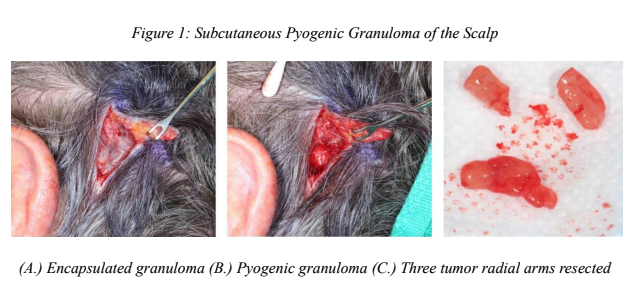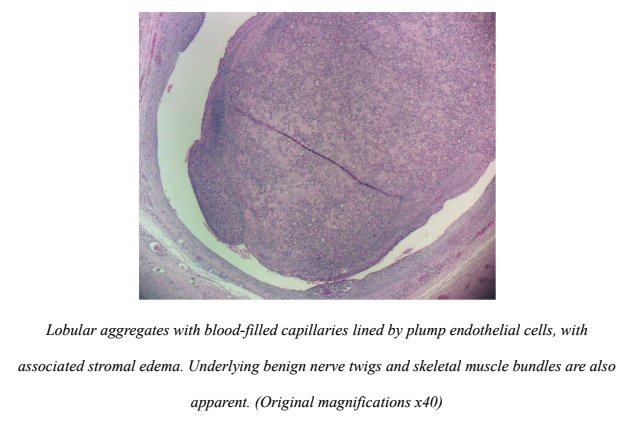Subcutaneous Intravascular Pyogenic Granuloma of the Scalp of a POEMS Syndrome Patient
ABSTRACT
An 82-year-old male with a past medical history of POEMS syndrome presented with a 6-week
history of a growing intravascular pyogenic granuloma in the subcutaneous scalp. Biopsy
showed lobular intravascular capillary hemangioma, also known as pyogenic granuloma. Lobular
capillary hemangiomas are most commonly found on the skin and represent some of the
cutaneous changes seen within POEMS syndrome. Rarely do they present subcutaneously or
intravascularly. When working up an intravascular subcutaneous nodule and developing a
differential diagnosis, POEMS syndrome should be considered.
INTRODUCTION
POEMS Syndrome is a rare multisystem disorder of monoclonal plasma cell dyscrasia.(1)
Manifestations include polyneuropathy, organomegaly, endocrinopathy, monoclonal
gammopathy, and skin changes. The latter are seen in up to 90% of patients.(2) Hemangiomas are
reported in 25 to 50% of patients with POEMS.(2) Associated cases of lobular capillary
hemangiomas (i.e. pyogenic granulomas) and, less commonly but more pathognomonic,
glomeruloid hemangiomas have been reported with POEMS.(2) Pyogenic granulomas present
cutaneously and are rare intravascular or subcutaneous.(3) We present a case of a growing
intravascular pyogenic granuloma of the scalp in an 82-year-old male with POEMS syndrome.
CASE
An 82-year-old man with previously stable POEMS syndrome presented with a 6-week history
of a growing subcutaneous mass of the left posterior scalp without prior trauma. At presentation,
his IgG levels were rising. The 1.5 cm mobile tender subcutaneous mass had three ballotable
radial arms. Open biopsy visualized dilated stellate blood vessels with rubbery tissue within.
Upon incision, a red mass slipped out of the vessel without active bleeding. (figure 1)

Full skin examination revealed other vascular lesions: multiple 1-2 mm cherry angiomas, a 2.5
cm right chest wall venous varicosity, and smaller right thigh and knee venous varicosities.
Vascular endothelial growth factor (VEGF) was within normal limits.
Histologic evaluation showed lobular capillary hemangioma. (figure 2) Wide local resection of
the remaining tumor was performed and the defect was closed with rotation flaps. There were no
recurrences or complications 3 years post-resection.


DISCUSSION
Pyogenic granulomas are benign vascular neoplasms of skin and mucosa. Histologically, they
show a lobulated capillary proliferation with mixed inflammatory infiltrate. Clinically, they are
exophytic, ulcerated, non-tender, and often bleed.(4) These tumors present as single dermal or
mucosal papules that have a predilection for the head, neck, and limbs, commonly the fingers. (4,5)
These usually evolve rapidly over a few months.
Although uncommonly found as intravascular or subcutaneous, 2 separate case series of such
capillary lobular hemangiomas have been published. Most common presenting locations were
the upper extremities (hands specifically) and the head and neck.(6)
These lesions have previously been attributed to higher levels of estrogen in women of
childbearing age and to areas of previous trauma.(5) To our knowledge we present the first
reported case of an intravascular capillary hemangioma in a patient with POEMS syndrome.
In addition to this unique presentation just beneath the scalp in an area of no prior trauma, our
patient also has POEMS syndrome. Common cutaneous changes in POEMS include
hyperpigmentation and hemangiomas. However, all these vascular lesions are dermal in nature.
Glomeruloid hemangiomas, specifically, are strongly associated with POEMS syndrome.(1) Other
vascular changes in POEMS include acrocyanosis, hyperemia, and Raynaud’s. Other POEMS
related skin changes are hypertrichosis, sclerodermoid changes, and clubbing.(2)
Clinical work-up for POEMS syndrome includes measuring VEGF 1 which promotes
angiogenesis and the development of vascular endothelial cells. VEGF can also be overexpressed
in pyogenic granulomas, but its exact role remains unclear. This highlights the possibility of
pyogenic granulomas in POEMS patients.
Our case illustrates a potential correlation between POEMS syndrome and the rare appearance of
intravascular pyogenic granulomas. More research needs to be done with a larger study to
determine causal relationships. We suggest considering a POEMS syndrome workup when
developing a differential diagnosis for a similar subcutaneous nodule, especially in the setting of
multiple other cutaneous vascular lesions as can present in a POEMS patient.
REFERENCES
- Amorim GM, Sodre C, Falcao EMM, Timbo RF, et al. Glomeruloid hemangioma as a late
manifestation of POEMS syndrome. Acta Dermatovenerol Croat. 2018;26(4):321-324. - Miest RYN, Comfere NI, Dispenzieri A, Lohse CM, et al. Cutaneous manifestations in
patients with poems syndrome. Int J Dermatol. 2013;52(11):1349-1356. - Barr KL, Vincek V. Subcutaneous intravascular pyogenic granuloma: a case report and review
of the literature. Cutis. 2010;86:130-132. - Koo MG, Lee SH, Han SE. Pyogenic granuloma: a retrospective analysis of cases treated over
a 10-year. Archives of Craniofacial Surgery. 2017;18(1):16-20. - Fortna RR, Junkins-Hopkins JM. A case of lobular capillary hemangioma (pyogenic
granuloma), localized to the subcutaneous tissue, and a review of the literature. Am J
Dermatopathol. 2007 Aug;29(4):408-411. - Dermawan JK, Ko JS, Billings SD. Intravascular Lobular Capillary Hemangioma
(Intravascular Pyogenic Granuloma): A Clinicopathologic Study of 40 Cases. Am J Surg Pathol.
2020;44(11):1515-1521.

